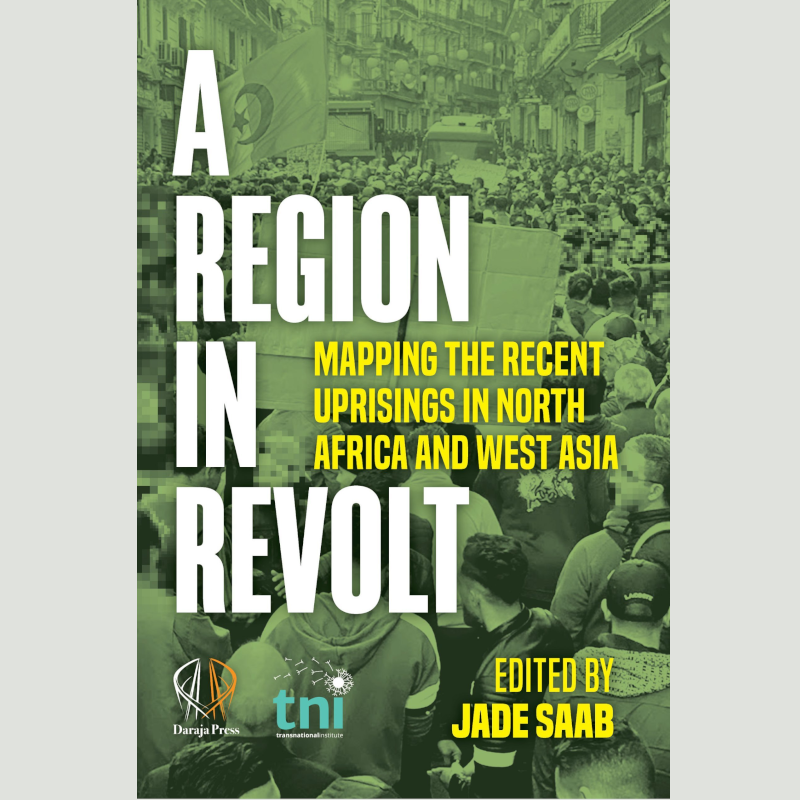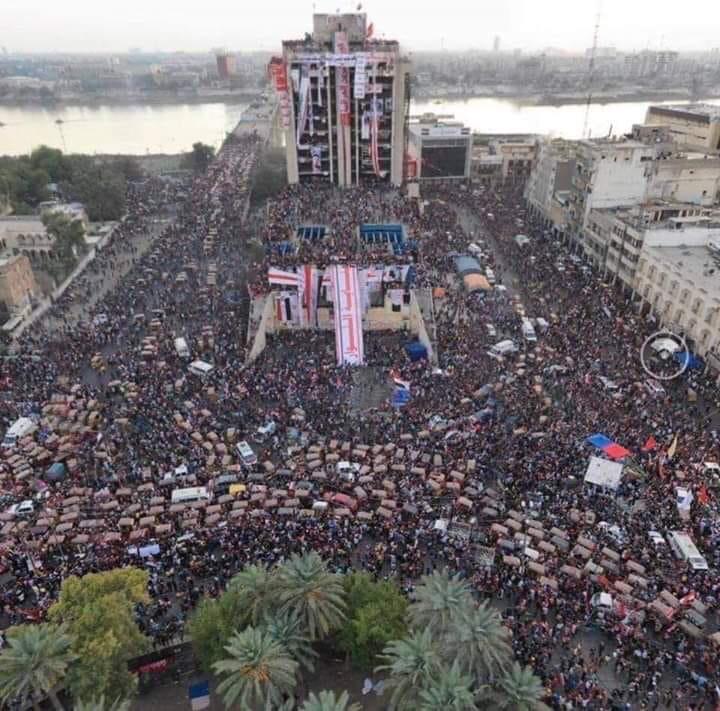Iraq’s October revolution

A Region in Revolt
Mapping the recent uprisings in North Africa and West Asia
by Jade Saab (Editor)
Daraja Press, 2020

Sam Salour summarizes A Region in Revolt: Mapping the Recent Uprisings in North Africa and West Asia edited by Jade Saab, a collection of essays that provides a comprehensive review of the 2018-2019 wave of struggle in the region. In the third part of this multi-part series, Salour provides an introduction to the book and then outlines the essay “Iraq’s October Uprising: Historical Context, Triggers, Discourse, Challenges, Possibilities” by Zeidon Alkinani.
Starting in 2018, a wave of revolutionary uprisings swept over the region commonly referred to as the Middle East and North Africa. Protesters in Sudan, Algeria, Iraq, Lebanon, and Iran took to the streets to demand the overthrow of their respective authoritarian regimes. While recognizing the common characteristics of these protests, the essays collected in the book A Region in Revolt: Mapping the Recent Uprisings in North Africa and West Asia emphasize the specific historical, political, and economic contexts of each country, highlighting the key actors involved, their goals, their weaknesses, and their possibilities.

The economies of the region—in the absence of a developed manufacturing sector—rely on oil and gas exports. The wealth extracted from natural resources is distributed amongst corrupt elites and military apparatuses, while the domestic markets are opened up to the cheap goods of industrialized nations. Speculative adventures in real estate and banking siphon off capital, paralyzing domestic productive investment. The consequence for the vast majority of the population has been unemployment, marginalization, and poverty. These economic realities, along with the climate of corruption, political repression, oppression of women, and discrimination against minorities, created pre-revolutionary conditions in the region as a whole. Although all of these movements are revolutionary in their aspirations—demanding systemic change—it remains to be seen whether any of them can achieve revolutionary outcomes.
The movements in Algeria, Iraq, Lebanon, and Iran have been characterized by oppositional protests and the rejection of ruling elites, but have not been able to unite behind a set of positive demands. While the lack of leadership has prevented the co-optation of the movements by existing political parties, it has also hampered their further development. In October 2019, massive demonstrations emerged in Iraq in opposition to the ethnic-sectarian political system. Though not the first protests since the 2003 U.S. invasion and occupation of Iraq, this movement had a qualitatively different spirit. As in Sudan, Algeria, and beyond, people were moving beyond asking for reforms to demand systemic change. The movement in Iraq toppled a prime minister and president but faced significant organizational challenges.
The authors of the collection emphasize the importance of regional and international solidarity against the powers of international finance. While the struggle against imperialism and global capital does not imply defending reactionary regimes such as the Islamic Republic of Iran as the lesser evil, it does require a revolutionary vision that goes beyond overthrowing national authoritarian regimes. Although the different uprisings have shown awareness of the global setting of their struggle and the need for regional solidarity, concrete instances of collaboration are yet to come. It is the role of the global Left to help create the space for practical solidarity between movements.
Most of the essays in this collection are written by members of the Alliance of Middle Eastern and North African Socialists. The Alliance originally started in March 2016 as a grouping of Syrian and Iranian Socialists with a trilingual website (English/Arabic/Persian) to help express the aspirations of “the Other Middle East” to offer analyses of critical issues, host new conversations, and build bonds of solidarity between Syrians and Iranians opposed to their respective authoritarian regimes. Since then, the Alliance has grown to include members in all the countries covered in this collection (and others) while continuing its mission to provide and amplify socialist perspectives from the region.
Iraq’s 2019 October revolution
Activist-scholar Zeidon Alkinani places Iraq’s 2019 October uprising within the context of the disastrous 2003 U.S. invasion and occupation of Iraq. On April 9, 2003, the U.S. formed an Iraqi Governing Council with membership distributed along ethno-sectarian proportions. This US-imposed ethnic-sectarian quota, or the Muhasasa framework, resulted in significant political polarization in post-2003 Iraq. For example, the Council of Representatives (COR) elected in the December 15, 2005 parliamentary elections chose premiership for Shiite Arabs, presidency for the Kurds, and a Sunni Arab to head COR. In 2006-8, Iraq experienced major violent sectarian conflicts resulting in thousands of deaths and millions of refugees. In 2013, partly in response to the ongoing protests since the “Iraqi Spring” of 2011, there was a further escalation of sectarian conflicts resulting in 7157 deaths. This identity-polarized system, alongside a fragile security situation, ultimately serves the interests of the domestic elites. Most of Iraq’s political leaders are also the country’s richest people who reportedly looted around 300 billion U.S. dollars from the Iraqi state between 2003 and 2020.
In mid-July 2015, in response to economic crisis, political corruption, and an expanding ISIS, protests erupted over poor public services in southern cities and ultimately reached the capital, Baghdadl. After the assassination of 18-year-old Muntadhar al-Hilfi by Iraqi Security Forces, protests spread across the country condemning corruption and demanding the replacement of the ethnic-sectarian Muhasasa regime with a secular state. Protesters marched every Friday with demonstrations growing to 700,000 – 800,000 people by the third week. Although up to 80% of Sunnis supported the protests, they did not participate in large numbers for fear of arrest on terrorism charges. The threat of ISIS was a major weapon in the government’s hands to quiet the protesters. However, with ISIS weakened, deepening corruption, a weak economy, and continued political sectarianism, Iraqis were pushed to the brink and the government was doing nothing to improve the situation.
Months before the 2019 October uprising, unemployed graduate students organized sit-ins in front of their affiliated ministries. In a country that ranks amongst the top 20 in corruption, with a 25% unemployment rate, where 96% of people do not have access to healthcare and almost 40% are illiterate, the violent crackdown on the student protesters unleashed years of pent up anger. An October 1 demonstration in Baghdad organized for all Iraqis marked the start of an October uprising that represented a radical step forward from the 2015 protests. People were no longer asking for services or jobs. They were demanding the overthrow of the entire system—echoing sentiments in Sudan and Algeria.
Similar to 2015, the October uprising soon spread across the country to the mostly Shiite provinces, the city of Kut, and the center of Wasit governorate. Prominent unions went on strike. Fears of a re-emerging ISIS and of government arrests kept the Sunni areas quiet, but Sunni participation in ethnically mixed cities signified their support for the protester’s demands. The Kurdish situation is rather different. Although Kurds in post-2003 Iraq have a long tradition of struggle and resistance against their own elites, many did not see this protest as one of their own but as a potential threat to the fragile security and economic advantages secured with their growing autonomy since 2003. While sympathetic towards the demands of the protestors, the Kurds’ absence is an issue that may not be tackled in the short term but must be addressed in the long term.
The uprising reached its peak on November 29, 2019 as the Prime Minister Abdul Mahdi resigned following the killing of 24 protesters. About a month later, on December 26, President Barham Salih handed in his resignation. Protesters celebrated but had no illusions that such a victory was more than symbolic. They continued to demand that the sectarian Muhasasa system be eradicated and a secular democracy take its place, with an end to corruption and to Iraq’s dysfunctional public services, economic mismanagement, and high rates of youth unemployment.
An important secondary demand was to end the imperialist ventures of the U.S. and Iran in Iraq. The violent suppression of the protests culminating in 800 deaths and 30,000 injured established an even stronger resistance towards the Iranian regime that funds 40% of the Shiite militia in Iraq. Protesters ripped down posters of Iran’s supreme leader Ayatollah Khomeini and torched the Iranian consulate and offices of pro-Iran political parties.
The movement rejected all political groups associated with the government, particularly those serving the interests of the Iranian imperialist regime. However, they have been unable to form their own stable independent organizations/institutions at both the grassroots and leadership levels akin to the grassroots Resistance and Change Committees in Sudan.
Although a wide variety of groups and committees have been formed by independent activists, students, leftists, secularists, and others circulating their statements across social media, none of them speaks for the movement as a whole. This lack of leadership has been both the greatest weakness and the greatest strength of the movement. On the one hand it has prevented forms of collective mass action to disrupt “business as usual,” allowing the media to portray the protests as disruptive acts of a minority. On the other hand, it has saved the movement from being co-opted by existing political entities that have lost legitimacy in the eyes of the protesters.
While the revolutionary uprising may not have achieved its demands, it has certainly paved the way for future struggles. The regime is neither capable of nor interested in implementing the drastic measures required to battle corruption, sectarianism, unemployment, and foreign intervention. During the stalemate brought about by the COVID-19 pandemic, it is the role of revolutionaries to think through what has been lacking in the revolutionary process that has hindered the development of a leadership with a clear alternative vision that is inclusive of all Iraqis.
Categories
We want to hear what you think. Contact us at editors@tempestmag.org.
Sam Salour View All
Sam Salour is a writer and activist in New York City. He is a member of DSA and the Tempest Collective.
